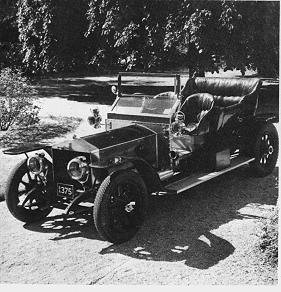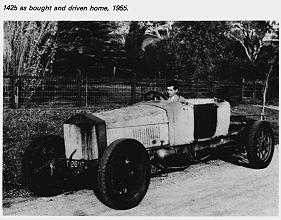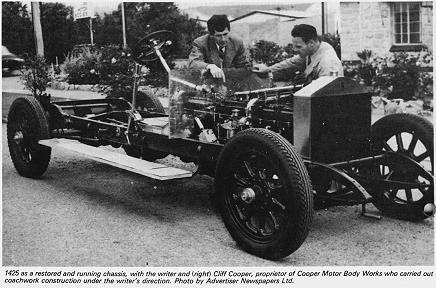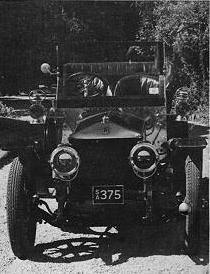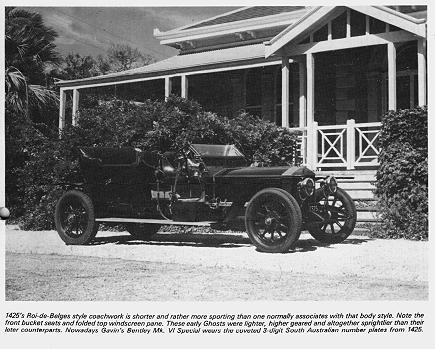From RROCA-info
The Resurrection of 1425
by Gavin Sandford-Morgan, 1988
I think I first saw Rolls-Royce Silver Ghost Chassis No. 1425 in an Adelaide street in about 1946. My recollection is of an obviously elderly Rolls-Royce fitted with a large and rather unattractive Australian-built tourer body, and rather resembling a large Hudson or Buick of the 1920s.
It was of interest, being a Rolls-Royce, but then ALL cars were of interest to me to a greater or lesser extent, and for that matter still are. However, as the extremely proud new owner of the then only "Blower" 4� litre Bentley in Australia, bought with my deferred pay and enforced savings during the War, elderly Rolls-Royces did not excite more than passing interest.
My motoring activities over the next few yearn concentrated on the faster vintage cars, and those younger racing cars which were within my financial reach, their application being in the form of road racing, hill climbs, trials, and rallies.
Then the mid 1960s saw a world-wide upsurge of interest in Veteran, Edwardian, and all types of pre-1918 motor cars and motorcycles. A major factor, no doubt, was the appearance of that delightful film "Genevieve" at that time.
Since South Australia is the home of the second oldest Veteran Car Club in the world, founded in 1934, I had peviously taken part in several Veteran rallies, and generally had taken some interest in this type of motoring activity, though well removed from my more active interest in road racing and hillclimbs. However, I found myself bitten by the veteran car bug, and although I admired the more primitive and lower-powered veteran and Edwardian cars, I decided that my veteran car had to GO! As there did not appear to be any early racing cars to be found, the alternative was a large engined 1914, or earlier, machine, and, as a result of my previous enjoyment of Rolls-Royce products, it was not hard to decide that what I would really like was a veteran "Silver Ghost".
I therefore started a systematic search and since no one else at this stage seemed to have hit on the same idea, I managed, within a relatively short period, to acquire a 1910 Ghost, chassis no.1425, in dilapidated but driveable condition; an even more dilapidated Ghost, chassis no. 2104, and an incomplete but towable chassis, no. 1524.
The 1910 chassis, no.1425, had suffered the fate of most old touring cars in Australia and had been converted to a farm buckboard. This process consists of chopping off the body from the back of the front seat rearwards, and constructing, with various levels of skill and design a goods or stock carrying wooden or metal tray. Ghost no.1425 had suffered the further indignity of being fitted with a Ford V8 carburettor but was otherwise in basically sound and ofignal condition, except for having been rebodied in the mid 1930s, when the radiator was raised, and various other "modernisation" improvements carried out. It also had the advantage that, apparently very early in its life, it had been fitted with steel Sankey wheels, which would accept available "inch" size tyres, thus avoiding the problems created with elderly wooden wheels, or the expense of converting wire wheels from rims carrying non available metric tyres to available "inch" tyres.
The car was remarkably complete mechanically, still with its original instruments, although these had been mounted on a wooden instrument panel which, together with the alterations to the radiator mountings, to achieve a higher bonnet line, had all been carried out when the Australian-built tourer body had been fitted c.1928.
I realise now how lucky I was when I recollect that so many difficult-to replace items such as the steering wheel, with its original covering, the aluminium engine trays and valances, and many other hard-to-obtain or reproduce components were all present and correct.
I drove 1425 home from its resting place some 60 miles south of Adelaide, despite its protests at the indignity of the Ford carburettor. The high overall gearing, and the stiff three-quarter elliptic springs enabled it to trundle along quite happily over twisting roads - so well did it trundle that after much yowling of tyres and horn blowing, I stopped to see why the friend following me appeared to be so agitated. He assured me that he was driving the Austin A70 at its quite respectable cornering limit but it was unable to keep up with the Ghost's deceptive handling ability!
Silver Ghost no.2104 had been a complete car with handsome Mulliner touring body, in the hands of its original owner until 1947, and maintained by a Rolls-Royce trained chauffeur/mechanic. With the renewed availability of new cars post-war, it had been sold, and had disappeared to the sparsely inhabited West Coast area of South Australia, some 600 miles west of Adelaide. There it had been converted into the inevitable buckboard, and passed into the hands of a local fisherman who was in the habit of driving it into the sea so that he could unload his catch from his boat into the Ghost. The poor old car had accepted this treatment for some years, but had finally succumbed to a broken axle shaft when trying to refloat a stranded boat.
I found it abandoned on the beach still reasonably complete mechanically, and still with the front half of the Mulliner body, but showing much rusting and corrosion caused by its seafaring experiences. I was able to buy it for �15, and eventually transport it back to Adelaide.
Ghost no.1524 was given to be by a friend, on the understanding that I would sell the good tyres with which it was equipped, and give him the proceeds. He in turn had obtained it from a friend who came from a motoring family which owned several sheep station properties north of Adelaide. This family had bought many interesting cars both new and second-hand over the years, and many of them, or their bones, were still to be seen in and around the station properties. With the upsurge of interest in veteran cars, members of this family put several of their complete cars into running order, and very generously allowed other enthusiasts to scavenge the station rubbish dumps. As a result, a number of now beautifully-restored old motor cars owe their genesis or phoenix-like reconstitution to major parts and components rescued from these same treasure trove rubbish dumps.
Ghost no.1524 had been found by one of the family members acting as a taxi at Port Adelaide, and after some negotiating, which legend suggests was an aftermath of a particularly enjoyable party, was bought on the spot and driven back to the station where it was used for some years as general station transport. When acquired by my friend it had lost all its body and many of its smaller components, and in fact had been serving duty as part of a fence!
What neither I nor my benefactor knew at the time was that it had originally been his grandfather's very beautiful Barker Brougham named "The Dreamer" after the charming little bronze bust of a wistful-looking young girl which had been fitted to the radiator cap as a mascot It is nice to know that well-detailed photographs of the car have survived in the family album. These have assisted in its restoration by another Adelaide Ghost enthusiast, who has fitted it with a beautifully built replica of the original body. As a final fitting touch the bronze of the dreaming girl, which was removed from the car before it was sold by the original owners, has been given to the present owner, and is now back in pride of place on the car's radiator cap.
Having found myself the owner of no less than three veteran Silver Ghosts, I now set about restoring 1425. Mechanical overhaul of the major components and chassis did not present too many problems, while missing or damaged small items could in some cases be cannibalised from my other two Ghost chassis, despite the head-scratching involved in sorting out the peculiarities of the control-mechanism variations between "A", "B", "C" and "D" steering columns. Today this smacks of sacrilege, but in 1955 it seemed to be quite a sensible way to speed the resurrection of a veteran Silver Ghost. The body presented more of a problem, both as to style of coachwork and construction, on a fairly limited budget.
At this stage I was lucky enough to be told of a suburban tennis court which for many years had used "part of an old car body" as a garden seat. Inspection showed it to be the rear seat, complete and in reasonably good condition, of a large veteran car circa 1910, and, yes, I could have it for my Rolls-Royce. Fortune then smiled on me even more broadly, since rummaging in the garage of the same house revealed, to my delight, the two back doors from the same body, and parts of the ornamental mouldings.
Mounting these precious items on the chassis showed that they would fit without much trouble, and further indicated that they would form a suitable basis for the relatively easy-to-create "Roi-des-Belges" style of body which is attractive and appropriate to the period, and which has proved so popular with subsequent restorers of veteran Silver Ghosts and other large cars of the period.
In the course of my original search for Rolls-Royces, I had also visited and wangled my way into the gardens and coachhouses where hearsay or the recollections of older friends told me that early Silver Ghosts had once lived. These visits yielded a number of valuable items, including the complete framework of a double pane folding windscreen, and a pair of excellent Lucas "King of the Road" acetylene headlights of the correct size and period.
Much studying of photographs, together with information obtained both in Australia and England, and the enthusiastic help of a local small body-building company enabled me to achieve the line and proportions of body and mudguards which appeared to be appropriate to the period.
Finally, the car was brush painted and lined by a firm which specialised in the building and maintenance of one of the fleets of horse-drawn bakers' carts which were still in wide use in the Adelaide suburbs at that time, and for some years subsequently.
It had been announced that the first major Australia-wide Veteran Car Rally would be held in Melbourne in November 1956, to coincide with the Melbourne Olympic Games. I thus had a worthwhile target to aim for as a completion date, and with much burning of midnight oil, and invaluable help from many friends, the restoration of 1425 was completed just in time to take part in this Rally.
Silver Ghost no.1425, was to the best of my knowledge, the first restored Rolls-Royce to take part in an Australian Veteran car rally. It therefore created much interest by not only being the only Rolls-Royce in this large Rally, but also by making fastest time in the two speed events included in the Rally. These consisted of a timed lap of a trotting track, and a timed climb up a long main road hill, which the Ghost breasted at some 40 miles an hour in second gear, in powerful contrast to the majority of the other veteran cars which were toiling and chuffing manfully up the same hill at speeds commensurate with their much smaller engines and lower gearing.
In addition to this evidence of its performance capabilities, 1425 was apparently selected to receive the Concours award, which would have been a nice tribute at this prestigious Rally. Unfortunately, residual rubbish in the fuel tank had caused several fuel blockages on this, its first long run, and the time lost on the road sections penalised it from the Concours awards.
One of the nicest backhanded compliments was when I was reprimanded by one of the officials for cruising at 60 miles an hour in heavy rain, his main complaint appearing to be that he was having trouble keeping up, and was unable to get past! In vain did I point out that in an open car with no hood, and an exposed body style, it was necessary to maintain this sort of speed to avoid getting wet!
Silver Ghost no. 1425 was, and according to its subsequent owner (of 30 years) still is a very satisfying car, since it has one of the highest available final drive gearings, which enables it happily to cruise at 60-85 miles an hour all day. The three-quarter elliptic rear suspension, although not as comfortable as the cantilever springing of the later Silver Ghosts, gives better handling under sporting conditions, while at the same time avoiding the slight tendency to rear-end steering which is a characteristic of the cantilever system. Many were the enjoyable dices I had with other motorists, both ancient and modem, and great was the surprise of conductors of potentially much faster cars who found the old Ghost to be a worthy competitor. One occasion I remember with particular pleasure was a dingdong uphill downhill battle with the 7-litre, 6-cylinder Gobron-Brille owned by another local veteran enthusiast. We were probably reaching 70 mph or more on the downhill bits, but the Ghost still had the edge on the Gobron-Brille, and also had noticeably better road-holding despite the comparative roughness of the road. It is certainly not hard to see why the veteran Silver Ghost was head and shoulders above any other pre-First World War high-performance production car.
I was lucky enough to enjoy the ownership of 1425 for several years after completing its restoration, years which saw it play its part in the formation of the South Australian Branch of the Rolls-Royce Owners' Club of Australia, its winning several major Veteran car awards, and, most importantly, being the car in which I courted the young lady who was subsequently to become my wife.
Unfortunately, the financial commitments of married life indicated that, when I received a tempting offer from Reg Hunt for the car, it would be prudent to relinquish it to him. My wife always said that I swapped a Rolls-Royce for her, but I was completely non committal on that subject!
It was nice to know that Reg Hunt kept and enjoyed the car for some 30 years after he bought it from me, and was a loyal and attentive custodian.
1425 seems to be a lucky and happy car, and I certainly hope that John Kennedy, its new owner, has equal pleasure and enjoyment from it.
